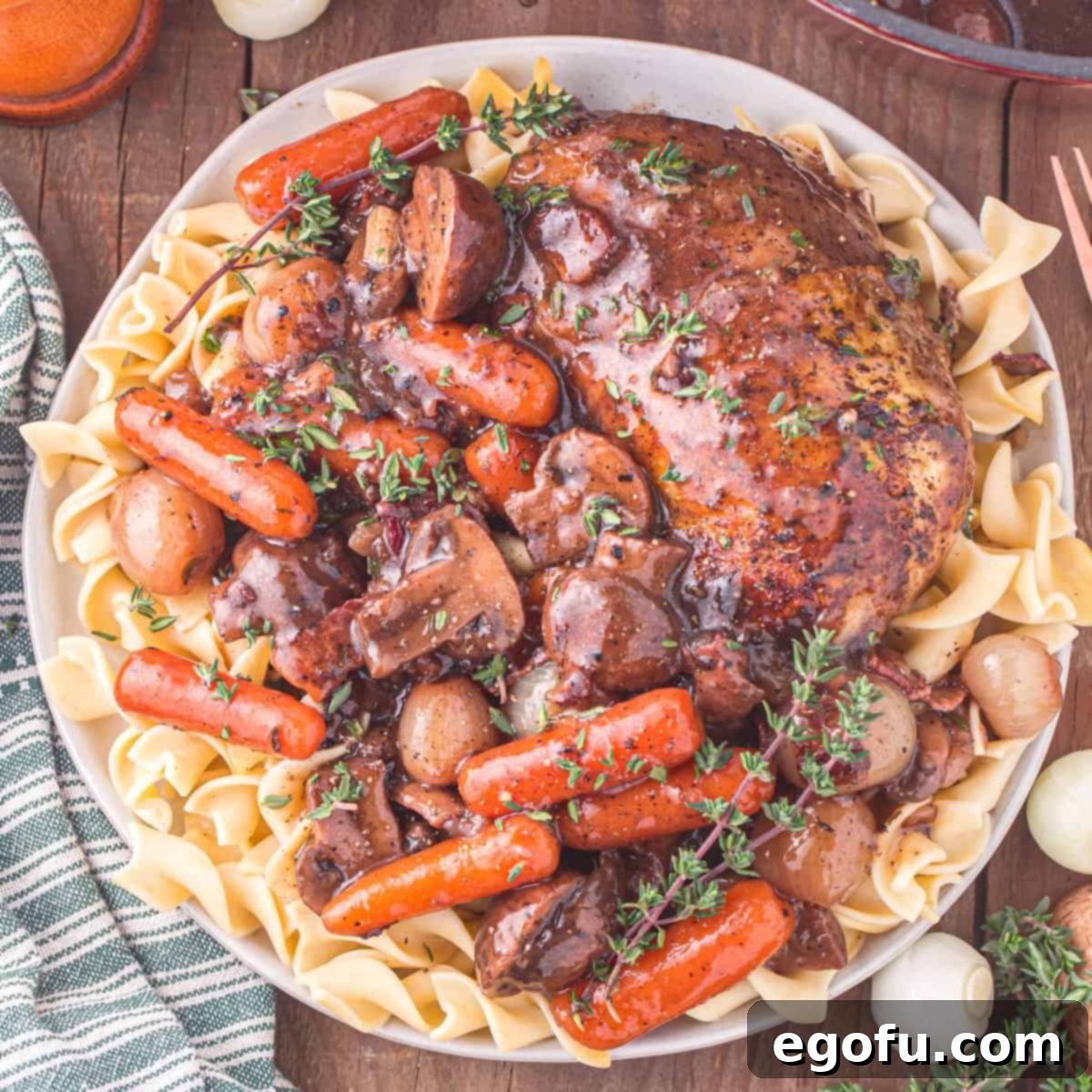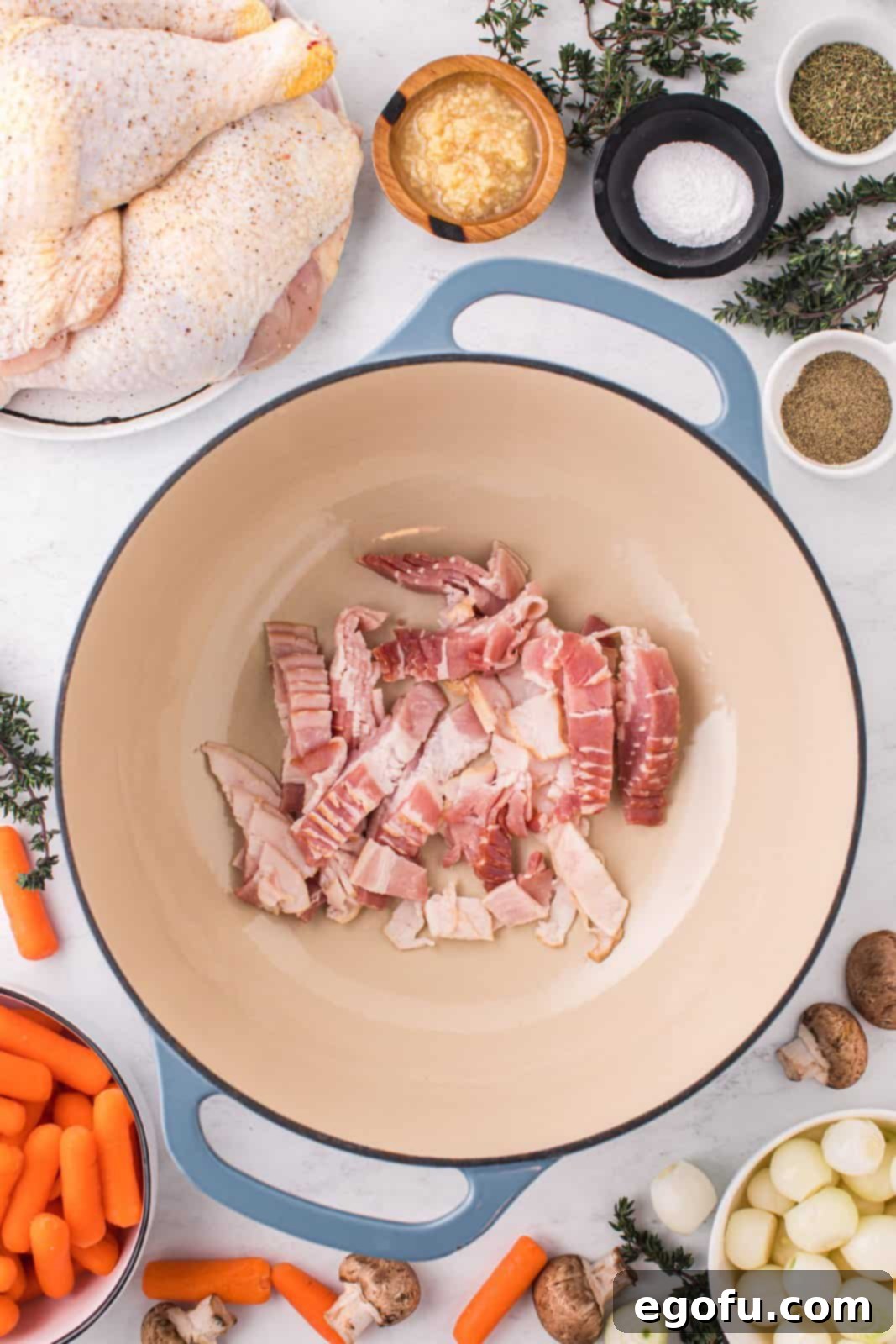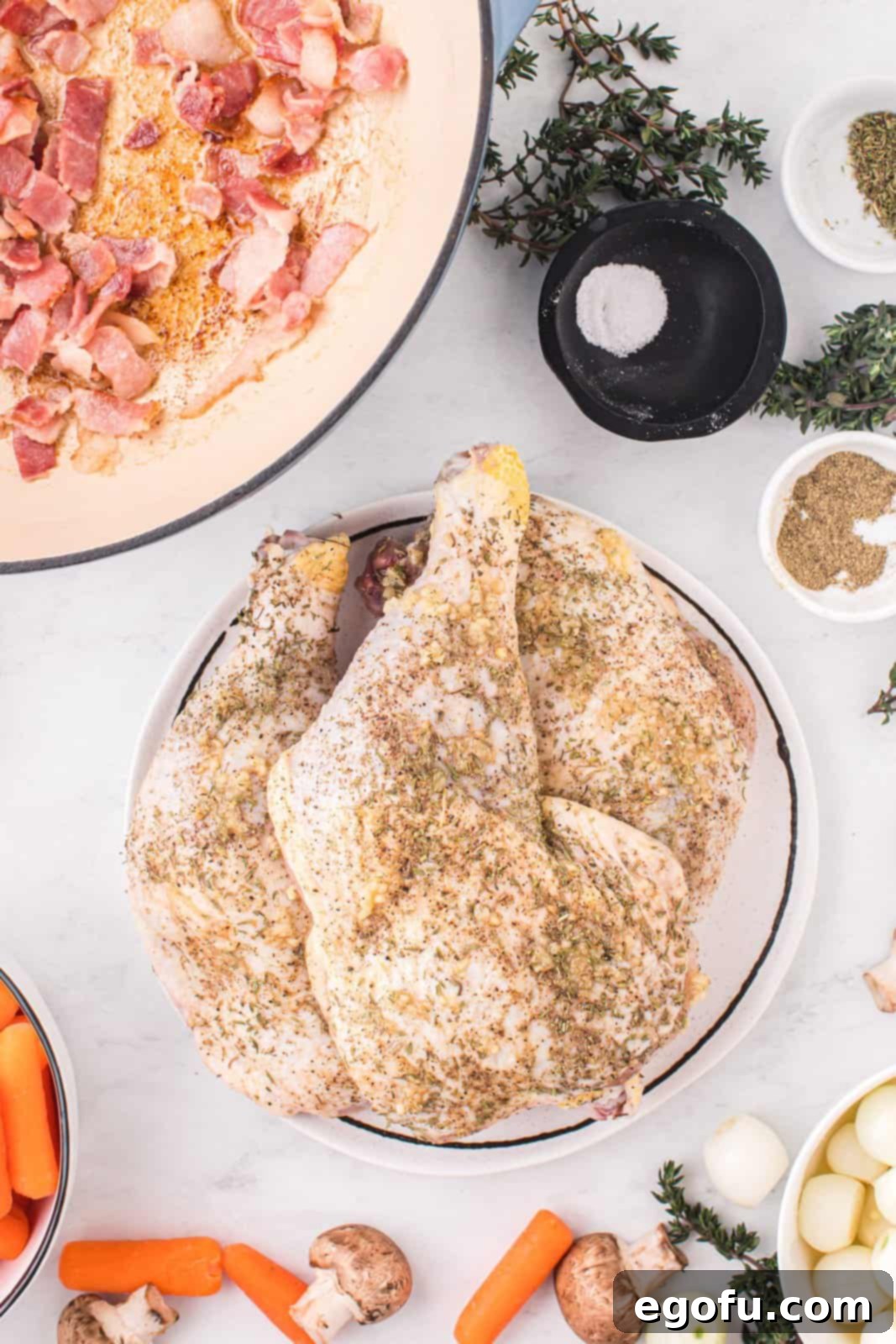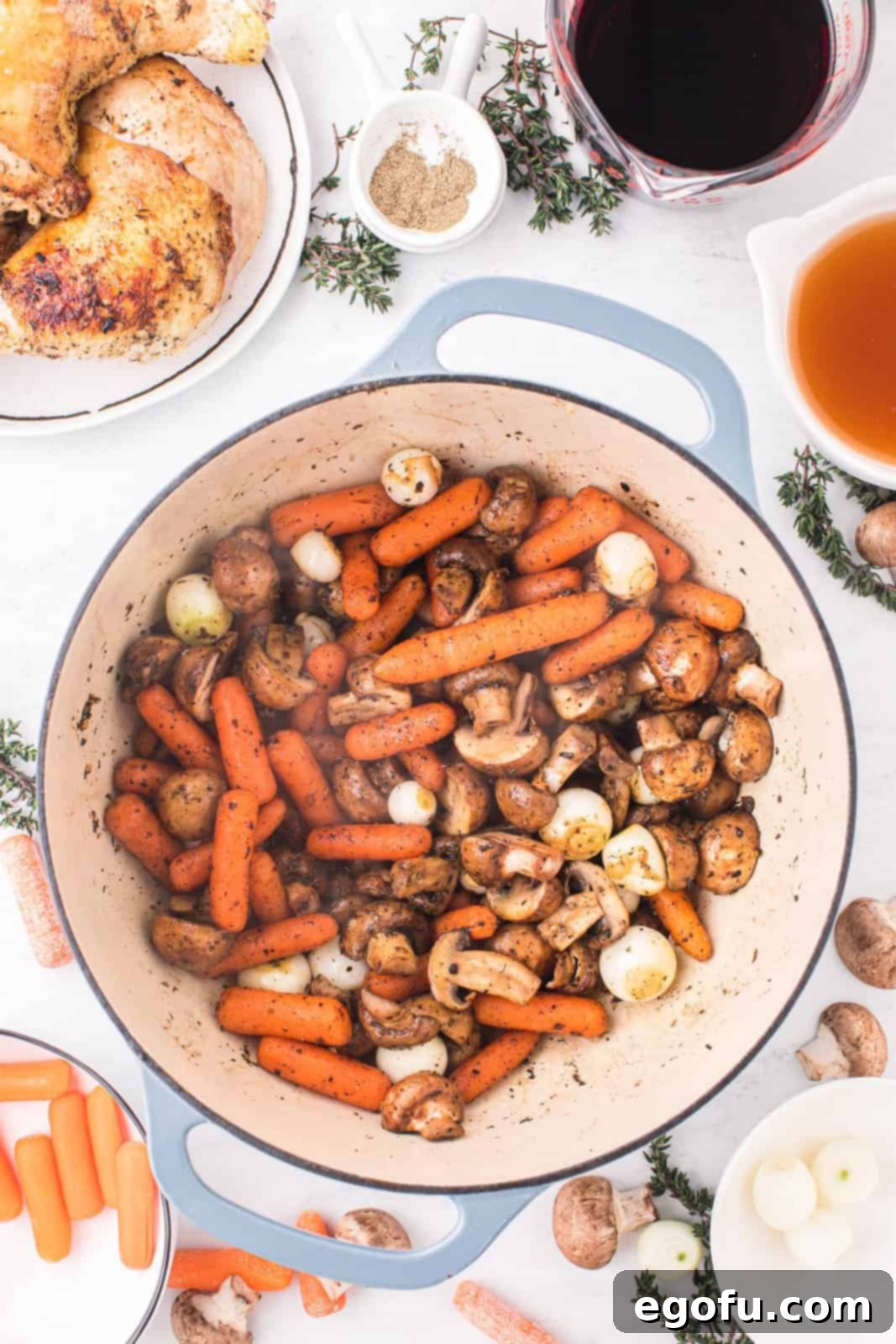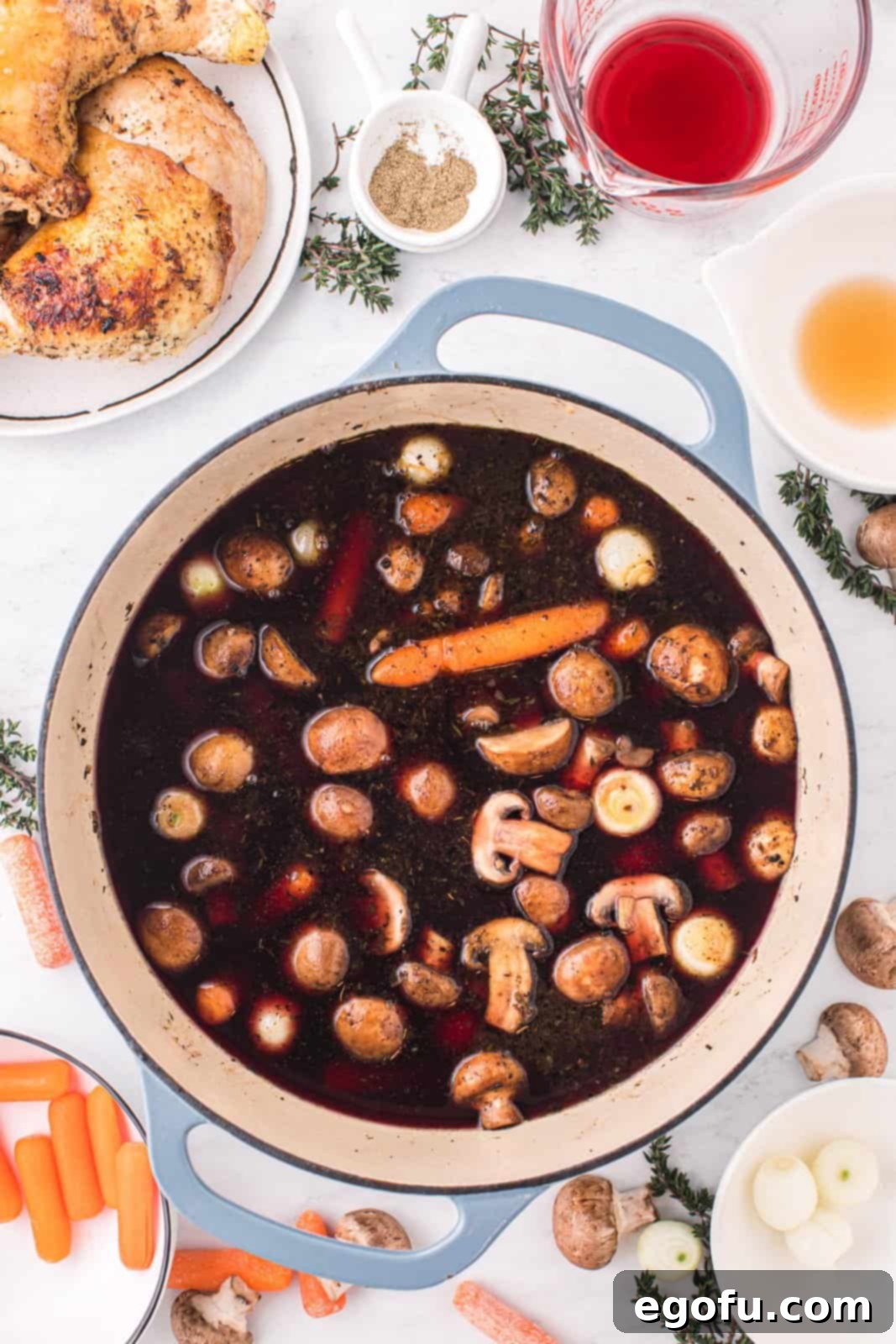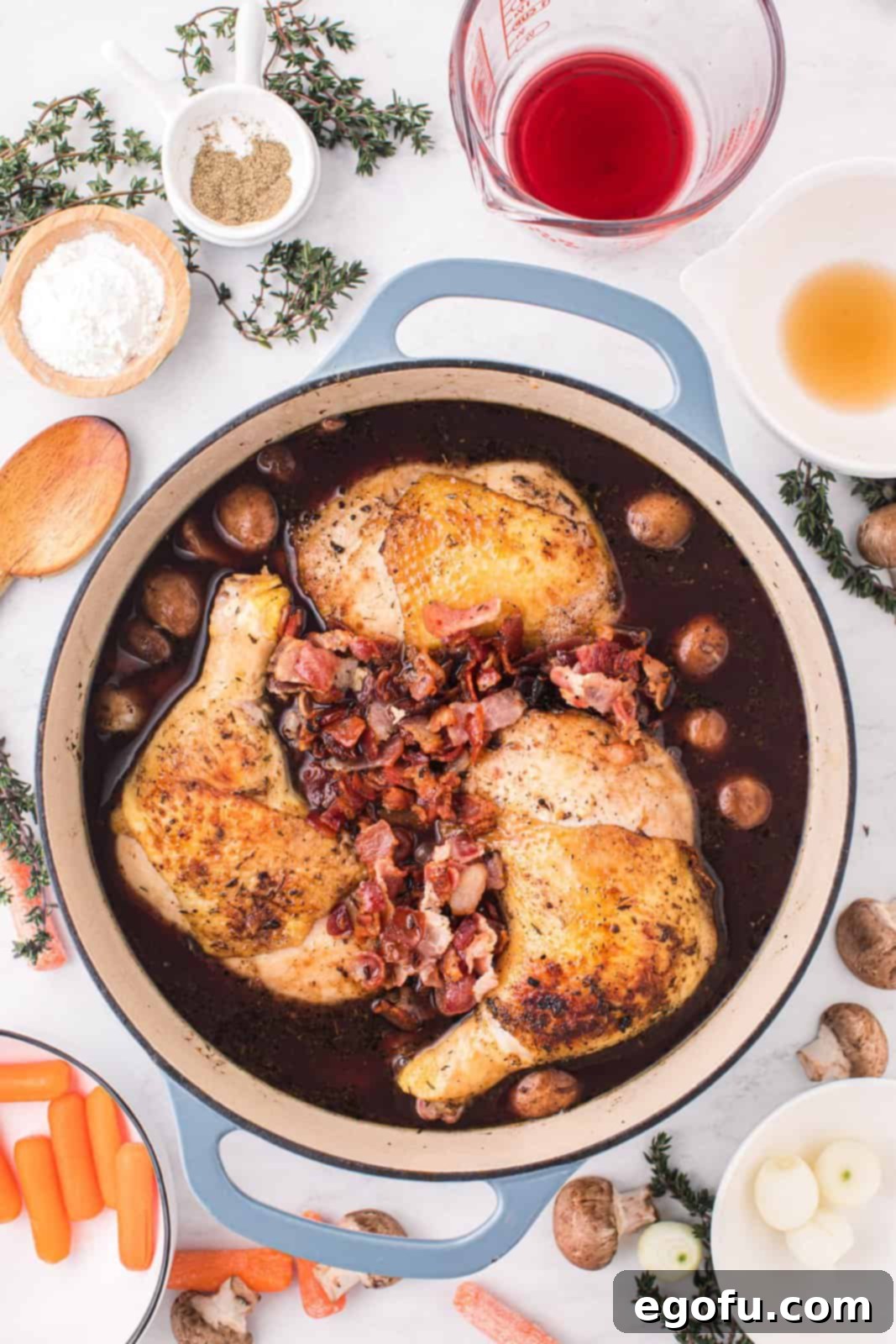Coq Au Vin, a classic French dish, often conjures images of complex, labor-intensive cooking. However, this magnificent recipe defies that perception, offering a truly simple yet elegant one-pot dinner that’s perfect for both weeknight meals and special occasions. Featuring succulent chicken, crispy bacon, tender vegetables, and a rich, deeply flavorful red wine sauce, it delivers a gourmet experience with surprising ease. Prepare to impress your family and guests with this rustic French masterpiece, all from the comfort of your own kitchen.
Unlocking the Elegance of French Cuisine: An Easy Coq Au Vin Recipe
The name “Coq Au Vin” might sound intimidating, hinting at hours spent slaving over a hot stove, but rest assured, this interpretation of the beloved French classic is remarkably straightforward. Our recipe is designed for the modern home cook, simplifying traditional techniques without compromising on the authentic, robust flavors that make this dish so iconic. Forget the need for a culinary diploma; with just a few key ingredients and easy-to-follow steps, you can create a truly memorable meal. Imagine juicy, tender chicken quarters bathed in a luxurious red wine sauce, complemented by earthy mushrooms, sweet carrots, and delicate pearl onions. This harmonious blend of textures and tastes transforms simple ingredients into an extraordinary dining experience, evoking the charm of a five-star restaurant right at your own table.
This recipe is more than just a meal; it’s an invitation to explore the delightful world of French-inspired cooking without the usual fuss. It’s about achieving profound depth of flavor through a careful selection of ingredients and a smart, efficient cooking process. The beauty of this one-pot method lies in how all the elements meld together, allowing the rich wine, savory chicken, and aromatic vegetables to create a symphony of taste that’s both comforting and sophisticated. The result is a hearty, satisfying dish that warms the soul and delights the palate, proving that truly exquisite food can indeed be accessible and enjoyable for everyone.

Frequently Asked Questions About Coq Au Vin
Coq Au Vin translates from French to “rooster in wine.” Historically, it was a way to tenderize tough roosters by braising them slowly in red wine. Today, it’s most commonly made with chicken, red wine, a rich broth, and an array of hearty vegetables like bacon, mushrooms, carrots, and onions. Despite its sophisticated name, the process is surprisingly straightforward, creating a deeply flavorful and comforting stew.
The consistency of the sauce is a matter of personal preference, and happily, it’s very easy to customize. After adding and heating the initial cornstarch mixture, if you desire a thicker sauce, you can repeat the thickening process. Simply whisk together another 2 tablespoons of cornstarch with 3 tablespoons of hot broth from the pot until smooth, then gradually stir it into the simmering dish. Continue this process, boiling for one minute after each addition, until your Coq Au Vin sauce reaches your desired velvety thickness. This method ensures perfect control over the final texture.
While chicken quarters are highly recommended for their rich flavor and moistness, you can certainly use other dark meat cuts. Bone-in, skin-on chicken legs or thighs are excellent alternatives that will yield similarly delicious results. We strongly advise against using white meat cuts like chicken breasts, as they tend to dry out easily and overcook during the longer simmering time required for this dish, which can compromise both texture and flavor.
Using chicken breasts is generally not recommended for Coq Au Vin due to their leaner nature and tendency to dry out quickly. Dark meat, such as chicken quarters, legs, or thighs, offers superior flavor and retains moisture much better during the braising process, resulting in a more tender and juicy final product. If you absolutely must use chicken breasts, opt for bone-in versions for added flavor and moisture retention. Be vigilant with cooking times, using a meat thermometer to ensure they reach an internal temperature of 165°F (74°C) without overcooking.
The wine is a star ingredient in Coq Au Vin, imparting deep, complex flavors. A Pinot Noir is an excellent choice, known for its fruity and earthy notes that complement chicken beautifully. Other fantastic options include Burgundy, Chianti, or a Côtes du Rhône. The key is to select a medium to full-bodied red wine that you genuinely enjoy drinking. A good rule of thumb is: if you wouldn’t drink it, don’t cook with it! These wines bring a rich, bold essence that perfectly marries with the savory elements of the dish.
Absolutely! This recipe is adaptable. For fresh thyme, use about three times the amount of dried thyme for comparable flavor. If you don’t have baby carrots, use whole carrots cut into 2-3 sturdy chunks; avoid thinly sliced carrots, which can become mushy. White button mushrooms can replace baby bellas, just keep them whole or in large chunks to prevent overcooking. Shallots or large chunks of red, white, or yellow onions are great substitutes for pearl onions. In a pinch, all-purpose flour can substitute cornstarch for thickening, but it may require a longer boiling time (3-5 minutes) to fully activate, so adjust timing to avoid overcooking the chicken.
While you can certainly cook chicken and vegetables in a rich broth, omitting the wine would mean it technically wouldn’t be Coq Au Vin, as “vin” (wine) is central to its definition and distinctive flavor profile. You can substitute the wine with an equal amount of chicken or beef stock, or a combination of both. However, doing so will result in a less complex flavor. To compensate for the missing depth, consider adding a quarter cup of red wine vinegar. This will introduce some of the acidity and tang, although it won’t replicate the nuanced flavors that a good red wine provides.
Pearl onions are small, round, marble-sized onions characterized by their mild, sweet flavor. They come in white, yellow, and red varieties and are frequently used in braised dishes, stews, salads, and as elegant appetizers. When cooked, pearl onions become delightfully tender and sweet, making them a wonderful addition to Coq Au Vin. You can often find fresh pearl onions in the produce section of well-stocked grocery stores, particularly in autumn and winter. Alternatively, many stores carry frozen, pre-peeled pearl onions, which are a convenient option. If using frozen, add them to the pot later, perhaps with the stock and wine (around step 8), to prevent them from becoming too soft.
Coq Au Vin is a remarkably complete meal on its own, packed with protein, vegetables, and a rich sauce. Therefore, it doesn’t strictly require elaborate side dishes. However, to complement its richness and add a fresh contrast, a simple, crisp green salad with a light vinaigrette is always an excellent choice. Additionally, many people enjoy serving Coq Au Vin over a bed of creamy mashed potatoes, al dente pasta, or even steamed rice, allowing the luxurious sauce to soak into these comforting accompaniments, creating an even more satisfying culinary experience.
Storing leftovers is simple, ensuring you can enjoy this delicious meal for days to come. Allow the Coq Au Vin to cool completely to room temperature before transferring it to an airtight container. Once sealed, it can be safely stored in the refrigerator for up to 4 days. This makes it an ideal dish for meal prepping or enjoying a convenient, gourmet-quality meal later in the week.
Yes, Coq Au Vin freezes beautifully, making it an excellent option for long-term meal planning. After allowing the dish to cool completely, transfer it to a freezer-safe container or a heavy-duty freezer bag. Ensure you remove as much air as possible before sealing to prevent freezer burn. It can be stored in the freezer for up to 3 months. When ready to enjoy, simply thaw it overnight in the refrigerator before reheating gently on the stove or in the oven.
Reheating Coq Au Vin is straightforward and helps maintain its delicious flavors and textures. For best results, you can gently reheat leftovers either on the stovetop over medium-low heat or in the oven at a moderate temperature (around 325°F or 160°C). If using the stovetop, stir occasionally to prevent sticking and ensure even heating. If using the oven, cover the dish to prevent drying out. Continue heating until the dish is thoroughly warmed through, typically 15-20 minutes on the stove or 25-35 minutes in the oven, depending on the quantity.

Essential Ingredients for Your Coq Au Vin
Crafting the perfect Coq Au Vin relies on a balanced combination of fresh, high-quality ingredients. Here’s what you’ll need to assemble this rustic French delight:
- Bone-in, skin-on chicken quarters for maximum flavor and moisture.
- Thick-cut bacon, diced, to render rich fat and provide smoky, savory notes.
- Minced garlic, a cornerstone of aromatic cooking.
- Salt and fresh black pepper to season generously.
- Dried thyme, offering an earthy, slightly floral herb flavor.
- Baby carrots, adding natural sweetness and vibrant color.
- Large baby bella mushrooms, washed and halved, for their umami depth and meaty texture.
- Pearl onions, peeled, contributing a delicate sweetness.
- Your favorite red wine, crucial for the signature rich sauce.
- Chicken stock, to create a flavorful braising liquid.
- Cornstarch, for perfectly thickening the luxurious sauce.
- Fresh thyme sprigs, optional, for a fragrant and elegant garnish.

Step-by-Step Guide: How to Make Coq Au Vin
Follow these detailed steps to create a show-stopping Coq Au Vin that’s rich in flavor and surprisingly simple to prepare. This one-pot method ensures minimal cleanup and maximum enjoyment.
- Begin by heating a large, heavy-bottomed pot or Dutch oven over medium-high heat on your stovetop. Ensure the pot is hot before adding ingredients.
- Add the diced thick-cut bacon to the hot pot. Sauté for approximately 3-4 minutes, or until the bacon begins to render its fat and becomes slightly crispy. This rendered fat will be essential for searing the chicken and sautéing the vegetables, building layers of flavor.
- While the bacon is cooking, prepare your chicken. Pat the chicken quarters thoroughly dry with paper towels; this step is crucial for achieving a crispy skin when searing. In a small bowl, combine 2 teaspoons of minced garlic, 2 teaspoons of salt, 1 teaspoon of dried thyme, and 1 teaspoon of fresh black pepper. Mix these seasonings together well, then generously rub this aromatic mixture over each chicken quarter, ensuring even coating.
- Carefully place the seasoned chicken quarters, one piece at a time, into the pot with the rendered bacon fat. Sear the chicken on all sides until it achieves a beautiful golden-brown color, about 2-3 minutes per side. Remember, you’re not cooking the chicken through at this stage, but rather developing a flavorful, crispy skin and locking in juices.
- As the bacon pieces become crispy, remove them from the pot and set them aside on a plate with the seared chicken. This prevents the bacon from burning during subsequent steps and keeps it perfectly crisp for later.

- Once all chicken pieces have been seared and removed, drain off all but 2 tablespoons of the bacon grease from the pot. This leaves just enough fat to sauté the vegetables without making the dish overly greasy.

- Add the baby carrots, halved large baby bella mushrooms, peeled pearl onions, the remaining 2 teaspoons of minced garlic, and the remaining teaspoon of dried thyme to the pot. Sauté these vegetables for about 4-5 minutes, stirring occasionally, until the herbs become wonderfully fragrant and the mushrooms start to turn golden brown and release their moisture. This step builds another layer of aromatic flavor.

- Gently pour in the red wine and chicken stock. Stir the mixture well, using a wooden spoon or spatula to scrape up any browned bits that have stuck to the bottom of the pot (this process is called deglazing, and those bits are packed with flavor!).

- Return the seared chicken quarters and crispy bacon to the pot, along with any accumulated juices on the plate. Gently stir everything together, ensuring the chicken is nestled comfortably in the liquid and vegetables.

- Increase the heat to medium to medium-high and bring the mixture to a boil. Once boiling, reduce the heat to a gentle simmer and cook uncovered for 35-45 minutes. The chicken should reach an internal temperature of 165°F (74°C) when a thermometer is inserted into the thickest part without touching bone. During this time, the alcohol from the wine will cook off, leaving behind only its rich flavor.

- Optional: As the Coq Au Vin simmers, you might notice some foam gathering on the surface. This is completely normal and can simply be skimmed off with a spoon and discarded for a clearer, more refined sauce.

- In a small bowl, whisk together the cornstarch with 3 tablespoons of the hot broth taken directly from the simmering pot. Whisk until the mixture is completely smooth and lump-free; this creates a “slurry” for thickening the sauce.

- Gradually pour the cornstarch mixture into the pot, stirring gently but continuously to incorporate it evenly. This will begin to thicken the broth, transforming it into a rich, luscious sauce. Bring the dish back to a gentle boil.
- Allow the Coq Au Vin to boil for just 1 minute after adding the cornstarch mixture. This ensures the cornstarch is fully activated and the sauce reaches its desired thickness. Then, remove the pot from the heat.
- Serve your exquisite Coq Au Vin hot. For an extra touch of elegance and fresh aroma, garnish each serving with a few sprigs of fresh thyme, if desired. Enjoy this flavorful and comforting French classic!
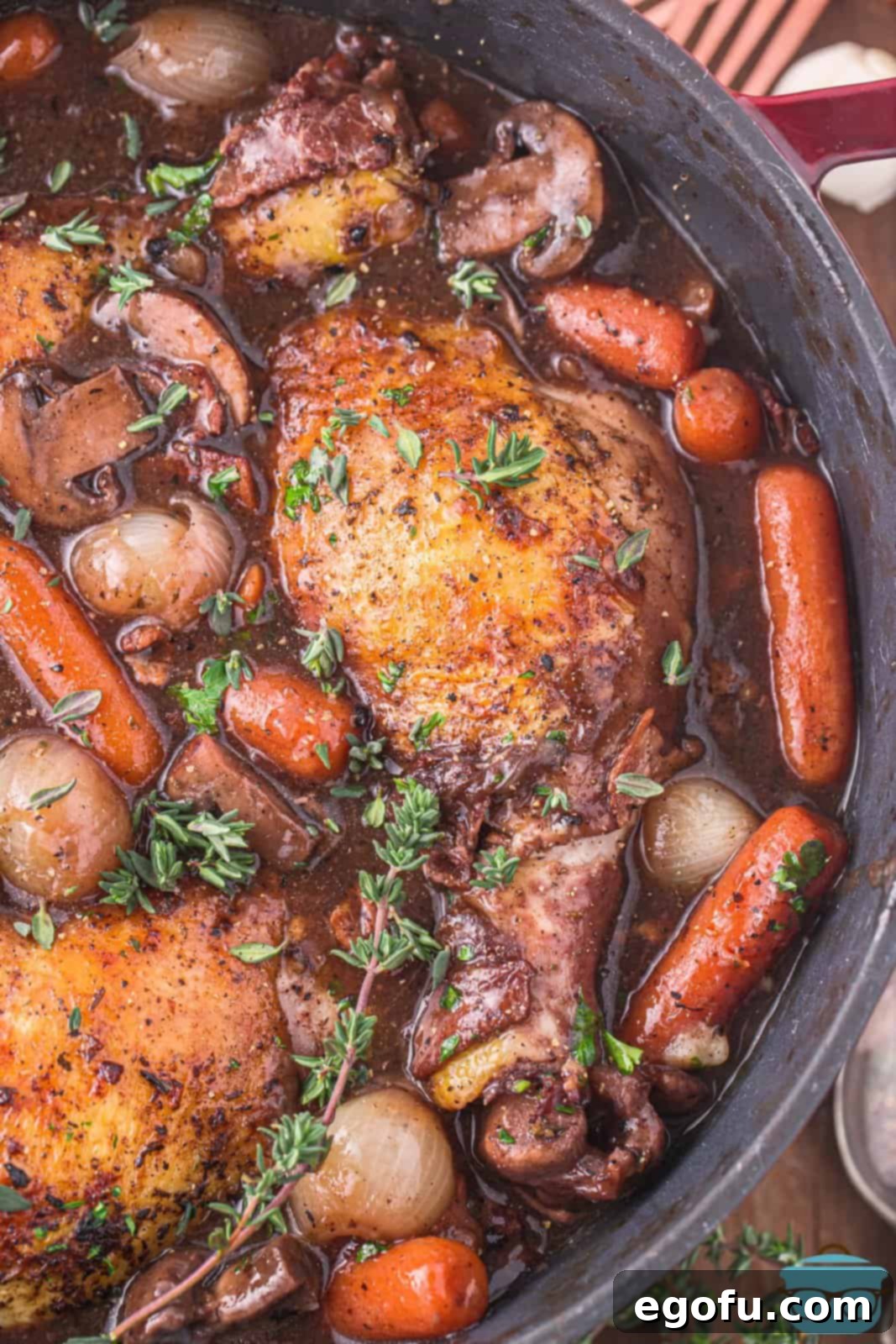
Craving More Delicious Recipes?
If you’ve enjoyed the comforting flavors of this Coq Au Vin, you’ll love exploring other hearty and satisfying dishes. Here are a few recommendations to expand your culinary repertoire:
- The Best Roast Chicken
- Crock Pot Mississippi Chicken
- Air Fryer Whole Roasted Chicken
- Crock Pot Rotisserie Chicken
- Instant Pot Whole Chicken
- Stick of Butter Rice


Coq Au Vin
Print
Pin
Rate
25 minutes
45 minutes
1 hour 10 minutes
5 servings
Brandie Skibinski
Ingredients
- 4 bone-in chicken quarters, with skin (room temperature)
- 7 slices thick cut bacon, diced
- 4 teaspoons minced garlic, divided use
- 2 teaspoons salt
- 2 teaspoons dried thyme, divided use
- 1 teaspoon fresh black pepper
- 2 cups baby carrots
- 16 ounce container large baby bella mushrooms, washed and halved
- 8 ounce container pearl onions, peeled
- 3 ½ cups red wine (whatever is your favorite)
- 2 cups chicken stock
- 2 Tablespoons cornstarch
Instructions
- Heat a large pot or dutch oven on the stove over medium- high heat.
- Add the bacon to the hot pot and saute for about 3-4 minutes (until it begins to render some grease.)
- While the bacon is cooking, pat the chicken dry with paper towels. In a small bowl combine 2 teaspoons minced garlic, 2 teaspoons salt, 1 teaspoon thyme and 1 teaspoon black pepper. Mix together then rub this mixture onto each quarter, as evenly as possible.
- Sear the chicken in with the bacon and grease, 1 piece at a time, until golden brown (about 2-3 minutes per side.) We’re not cooking the chicken all the way, just adding color to the skin.
- Remove the bacon from the pot as it gets crispy and place it on a plate to the side with the seared chicken.
- Once all the chicken pieces have been browned, remove all but 2 Tablespoons of the bacon grease.
- Add the carrots, mushrooms, pearl onions, remaining 2 teaspoons minced garlic and remaining teaspoon of dried thyme to the pot and saute for about 4-5 minutes or until the herbs are fragrant and the mushrooms are beginning to turn golden on the outside.
- Gently pour in the red wine and chicken stock. Stir until everything has come off the bottom of the pot.
- Return the chicken and bacon to the pot, along with any juices on the plate and gently stir everything together.
- Bring to a boil over medium to medium-high heat and then reduce to a simmer and cook uncovered for 35-45 minutes. The chicken should reach 165F degrees (thermometer inserted into the thickest part of the chicken without touching bone) and you shouldn’t smell the alcohol.
- Optional: While the Coq au Vin is simmering it may foam on the top. You can simply remove and discard any foam that gathers as it cooks.
- In a small bowl whisk together the cornstarch and 3 Tablespoons of the hot broth from the pot until smooth.
- Gradually pour the cornstarch mixture into the pot and gently stir until combined (this is going to thicken the broth a bit.) Bring the dish back to a boil.
- Boil for 1 minute and then remove from the heat.
- Serve hot, garnished with fresh thyme sprigs, optional.
Notes
- This recipe is versatile! Explore the various substitution suggestions provided in the FAQ section above to customize your Coq Au Vin to your preference or available ingredients.
- For the most authentic and robust flavor, always choose a medium to full-bodied red wine that you enjoy drinking.
- Bone-in, skin-on chicken quarters are ideal for this dish, offering unparalleled juiciness and rich flavor. However, bone-in chicken thighs or legs are excellent alternatives.
- Depending on availability, you can use either fresh or frozen pearl onions. If opting for frozen, they are typically pre-peeled and should be added later in the cooking process (around step 8) to prevent them from becoming overly soft.
- While it’s possible to make a chicken stew without wine, it won’t be Coq Au Vin. The wine is fundamental to the dish’s unique character. Refer to our FAQ for guidance on wine choices and non-alcoholic alternatives.
Main Course
French
Nutrition
Carbohydrates: 25g |
Protein: 31g |
Fat: 41g |
Sodium: 1545mg |
Fiber: 3g |
Sugar: 9g
Nutritional Disclaimer
“The Country Cook” is not a dietician or nutritionist, and any nutritional information shared is an estimate. If calorie count and other nutritional values are important to you, we recommend running the ingredients through whichever online nutritional calculator you prefer. Calories and other nutritional values can vary quite a bit depending on which brands were used.
